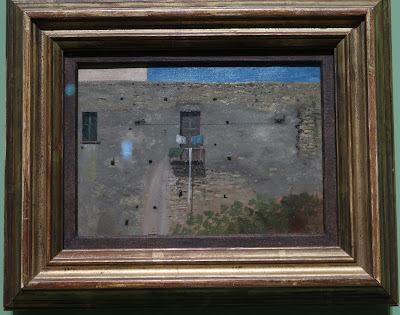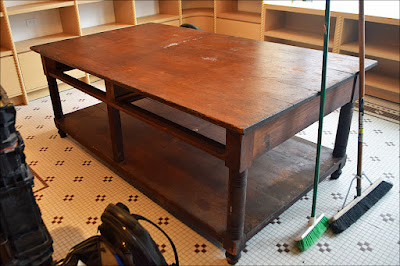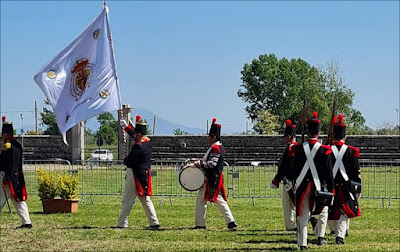April 30, 2024
John Rao's Latest Lecture, "Let the Spirit of the Times Be Damned!," is now Available on Soundcloud
April 29, 2024
Review: Briganti
Spoiler alert! I repeat, spoiler alert! If you haven’t already seen Netflix's Brigands: The Quest for Gold, this review will definitely spoil it for you. Do not read beyond this point.
Io sono un principe italiano illegalmente spogliato del suo potere, è qui l'unica casa che mi è rimasta, qui è un lembo della mia patria, qui sono vicino al mio Regno ed ai sudditi miei… vengono chiamati assassini e briganti quegli infelici che difendono in una lotta diseguale l'indipendenza della loro patria e i diritti della loro legittima dinastia. In questo senso anche io tengo per un grand'onor di essere un brigante! ~ Re Francesco II delle Due Sicilie (durante la permanenza in esilio nello Stato Pontificio) [1]
Not surprisingly, I have little good to say about Netflix’s new Italian ahistorical drama Briganti. Released on St. George’s Day (Tuesday, 23 April 2024), the six-episode miniseries tells the fanciful tale of the struggle between bands of brigands and occupying Piedmontese soldiers in Southern Italy looking for pilfered Bourbon gold. Buried somewhere in the “Badlands” of Basilicata two years after Garibaldi’s invasion of Sicily, the fabled treasure map unexplainably ends up in the possession of Don Clemente Degli Orti (Gianni Vastarella), a wealthy (and exceedingly violent) collaborator with the nascent Italian state.
As someone who enjoys period pieces, I thought the sets, scenery, and costumes were fantastic, though I’m not sure how authentic some of the firearms were. The one main exception to this is the cheering townspeople in the final episode. Dressed with heavy eye makeup, dyed beards, and braids, the menfolk looked a little too much like Captain Jack Sparrow from The Pirates of the Caribbean (2003-2017) for my taste.
 |
| (L-R) Giuseppe Schiavone (1838-1864), Carmine Crocco (1830-1905), and Filomena Pennacchio (left) with two other female freedom fighters |
Perhaps, at times, a little too much in the case of Michelina Di Cesare (Matilda Lutz). While eye-catching, the crimson dress and warpaint she wore in the season’s penultimate episode was more than a little over the top. Standing on the “altar” of a ruined church with ciborium and bucranium she looked like a savage Amazon more suitable for Mel Gibson’s Apocalypto (2006) or George Miller’s upcoming Furiosa (2024) than the famed Brigantessa her character was supposedly based off of.
 |
| Top: Matilda Lutz as Michelina Di Cesare. Bottom: (L-R) Anya Taylor-Joy (Furiosa, 2024) and Charlize Theron (Fury Road, 2015) as Imperator Furiosa |
Even more ludicrous was the sex scene with Filomena (Michela De Rosa) and Giuseppe Schiavone (Marlon Joubert), aka Sparrowhawk (Sparviero). After protecting her from being raped by their cellmates, the battered and bloody “Murderess” and “Curse,” as she is often called, seduces him in the cage next to the sleeping prisoners and guards.
Since they aren't following the true story of Filomena and Giuseppe, I don’t understand why he didn’t just kill her when they were forced to fight each other to the death by the bloodthirsty Stonebreaker Gang (Spaccapietre). It was totally out of character for the self-serving double-dealing cad to sacrifice himself for her, especially when, as it turned out, he was really in love with another woman the whole time.
 |
| (L) Michelina posing with guns. (R) "Aiming higher," Briganti's Michelina posing for a portrait dressed as the Blessed Mother with a rifle |
 |
| (L) Michelina with a bouquet of flowers. (R) The Piedmontese's handiwork |
The more I think about the show, the more confusing and inane I find it. The storyline is dumb and the writing is terrible. Why would Don Clemente marry lowly Filomena, an orphaned peasant girl beneath his station and whom he has nothing but contempt for? Why would he murder Filomena’s friend over a cup of water and then throw his wife into a well? If the water was so valuable, why would he risk contaminating the cistern with his wife’s body? None of it makes any sense.
 |
| I know I focus a lot on Michelina, but Filomena De Marco is the story's main protagonist. Her character is based on Filomena Pennacchio (1841-1915) |
During the big battle scene outside the church, why didn’t Michelina retreat with everybody else when they made off with the gold? Declaring, “We want victory,” she foolhardily advances toward the general and gets shot and captured. I get her wanting to kill Fumel, but while lying on the ground wounded her very next line was, “We have already won.” [!?!] If that was the case, then why didn’t she flee?
Even crazier, is why the briganti didn’t just open fire on the soldiers standing guard. Not only did they allow them to get into position, they let them shoot first. [!?!] A barbarous occupational force, the Piedmontese had no qualms about murdering innocent civilians or burning whole villages to the ground. For heaven’s sake, they collected severed human heads for Lombrosian experiments, so the hesitancy to obey their general’s command to shoot the populace was one of the most historically inaccurate parts of a series glutted with inaccuracies.
 |
| (L-R) The corpses of Nicola Napolitano, executed "Briganti," and Ninco Nanco |
Mindful of their poor track record and today’s progressive climate, I never really expected Netflix to air a good show. We also saw the way Pasquale Squitieri’s far superior and much more accurate Li Chiamarono…Briganti (They called them Brigands) was received and suppressed in 1999. Other than affording us the opportunity to discuss the lawless period, there is little value in the show. In fact, Briganti's one saving grace is the rendition of Brigante Se More by Gennaro “Raiz” Della Volpe, which serves as the series theme song. Maybe I’m being overly critical, but not since Amazon’s abhorrent Rings of Power (2022) have I sat through something this awful.
~ Giovanni di Napoli, April 28, Feasts of St. Vitalis of Milan and St. Paul of the Cross
Notes:
[1] I am an Italian prince illegally stripped of his power, here is the only home I have left, here is a corner of my homeland, here I am close to my Kingdom and my subjects...those unfortunates who defend in an unequal struggle the independence of their homeland and the rights of their legitimate dynasty. In this sense, I also consider it a great honor to be a brigand! ~ King Francesco II of the Two Sicilies (during his stay in exile in the Papal States)
April 28, 2024
A Look at the Napoli Ottocento Exhibit On View at the Scuderie del Quirinale in Rome
 |
| Reclining Woman Reading, Gioacchino Toma, c.1880 Photos courtesy of Cav. Danny Toma |
 |
| Country Road - A Hot Day in Sicily!, Francesco LoJacono, 1877 |
| The Iconoclasts, Domenico Morelli, 1855 |
 |
| A Wall in Naples, Thomas Jones, c.1782 |
 |
| A View of Naples through a Window, Franz Ludwig Catel, 1824 |
 |
| View of Naples from Sant'Antonio a Posillipo, Ercole Gigante, 1840 |
 |
| The Painter's Studio in Naples, Massimo D'Azeglio, c.1827 |
 |
| View of Mergellina, Silvestr Feodosievich Shchedrin, 1826 |
 |
| Capri, Karl Theodor Boehme, 1896 |
 |
| Aurora Borealis Effect, Salvatore Fergola, 1848 |
 |
| Riviera di Chiaia from Mergellina, Anton Smink van Pitloo, 1829 |
 |
| Eruption of Vesuvius from the Maddalena Bridge, Pierre-Jacques Volaire, 1782 |
April 27, 2024
April 24, 2024
Domenico Cimarosa: Overtures Arranged for Mandolin Ensemble
• Domenico Cimarosa: Overtures Arranged for Mandolin Ensemble performed by Quintetto a Plettro "Giuseppe Anedda"
Label: Brilliant Classics
Release Date: March 5, 2024
Audio CD: $13.99
Number of Discs: 1
Available at Amazon.com
Read description
New Book: I Borbone delle Due Sicilie e San Giorgio
New title that may be of interest to our readers. Available at Effigi.com
• I Borbone delle Due Sicilie e San Giorgio di Alessio Varisco
Publisher: Edizioni Effigi | Domus Templi
Publication Date: 2020
Paperback: €25.00
Language: Italian
Pages: 336
Click here to see more books
Listing does not imply any endorsement
April 23, 2024
Differentiated Autonomy Spoken About at Montecitorio
 |
| Fiore Marro and Pino Aprile at the Differentiated Autonomy Conference |
By Fiore Marro, President of the Comitati Due Sicilie
Translated by Charles Sant’Elia
Thanks to the invitation of the honorable Alessandro Caramiello, upon suggestion of the Comitati Due Sicilie representative in Giugliano, Campania, Espedito Basile, I was present at the meeting on differentiated autonomy which took place on 9 April 2024 in the Sala della Regina in the Montecitorio Palace [1]; the symposium was convened and organized by the honorable Caramiello himself, always attentive to the dialogue between the institutions and the territory.
It was nice to embrace again Luca Pepe the once very young meridionalista who is today a first rate journalist, who wisely moderated the conference.
The topic for in-depth analysis, differentiated autonomy, a central question in current internal politics in the nation but even more so for the future it would design for Italians should it be approved by Parliament, was detailed according to the views of profound and diverse observers.
Vice President of the Chamber of Deputies honorable Sergio Costa introduced the work, underscoring how much the system of differentiated autonomy regards the grasp itself of the Italian Republic. He further explained that there already exists an inequality between north and south, as far as for a citizen of the north the state spends 17,621 €, while for a citizen of the south 13,613 € on an annual basis, thus there is a difference in spending of about 80 billion. If the law on differentiated autonomy were approved now, these 80 billion euros would be added to the 190 billion euros which would be subtracted from the South. It is evident that it would no longer be possible to assure any type of basic service in the southern regions and thus taxes would need to be raised, but raising taxes would diminish the spending capacity of southern citizens and gradually would generate that vicious cycle that would lead to the emigration of southerners to the north, impoverishing the South of every resource, including humans.
The Vice President of the Chamber, formerly minister for the environment, quipped in his concluding remarks with a rather specific question: why did one want the unification of Italy if now one is doing everything to divide it? The response in our humble opinion is simple: back then one wanted Italy in order to drain the coffers of the flourishing Two Sicilies in favor of the Savoys, today one divides it because one has scraped the bottom and there is nothing left to pick clean in the South.
Unfurling the flag of the Kingdom of the
Two Sicilies inside Montecitorio
Subsequently honorable Caramiello took the floor, explaining he was the president of the parliamentary intergroup South Development, vulnerable areas and minor islands, which is organizing a series of events to compose and represent the south of Italy. This group is represented by 53 members of parliament of all political currents which work on common topics. Unfortunately however, today’s topic is not considered a common one, but a divisive one. The Lega Nord, in its inception, affirmed that if they didn’t reach secession they would become Romans and they are achieving that, in fact if the reform of the bill, already passed in the Senate, passes in the Chamber as well, it will be over for the South. Nonetheless there is no will for a dialogue because now that the hearings took place, when Professor Chieffi who took apart the law on autonomy line by line was heard, he received no response from Calderoli, but rather received the usual insults of the type “the Neapolitan who cries and *****”.
The presentations of the constitutional experts were touching for those who love the Italian Constitution, there was a barrage on the part of the speakers against this bill which ever more resembles an assault, they rattled off topics and quibbles, which appear can block from the start this wholly Padanian idea of turning upside down the Italian political system; the problem remains, in our humble opinion, that while here one studies the illness, the patient dies, also because those who presented this bill hold the majority in Parliament and thus can calmly proceed with their own destructionist attempt.
The one who for a time lapse, gave strength again to southern hopes on the other hand, was our dear Pino Aprile, who, in the guise of a reborn Beneventano del Bosco, loudly and with all his soul harangued a harsh criticism against those who brought forth this infamy. Important for the undersigned, was the moment in which the identitarian writer held forth the idea that the South, could indeed benefit from a potential division of the Italic territory, perhaps not immediately, but in the span of a few years.
The South of Italy was decided upon manu militari, but only for a mere question of economics and finance, and above all so as to demolish the Bourbon customs duties, paradoxically this idea of regional differentiated autonomy in our humble opinion could be a sort of return to the past, by reproposing with specific laws a sort of regional customs duty, as far as concerns the revenue of certain products of exclusive Padanian production. The solution is at hand, posterity shall judge.
Notes
[1] Montecitorio, the palace in Rome housing the Italian Chamber of Deputies, designed by Bernini and Fontana and originally built in the 17th century for Cardinal Ludovico Ludovisi, and which formerly housed the Papal law courts and city administration during the time of the Papal States. After the annexation of Rome and transfer of the capital of Italy in 1870 it was seized and used as the Chamber of Deputies.
April 22, 2024
A Sneak Peek Inside New York City’s Forthcoming Italian American Emporium
 |
| Entrance to the Italian American Emporium on Mulberry Street |
Looking forward to the soft opening in late May or early June, we wish our dear friend John and his partners much love and success in this exciting new venture.
 |
| Entrance to Red Sauce Studio on Grand Street |
 |
| (L) Neon corner sign. (R) Antique cash register (just for show) |
 |
| A side view of the ornate register |
 |
| Owner, John Viola gave us a tour of the impressive facilities |
 |
| The t-shirt bar |
 |
| Sicilian carrettu themed display table |
 |
| This uninstalled chandelier will be decorated with Neapolitan cornetti and mano fico amulets |
 |
| Ornate porcelain chandelier |
 |
| An old-fashion chandelier |
 |
| (L) The AI interactive "oral history booth." (R) Purely decorative antique cigarette machine |
 |
| A look at the brands of cigarettes the machine once dispensed |
 |
| An antique oven dominates the kitchenware section |
 |
| John's old dining room table now serves as a display table |
 |
| The register counter |
 |
| Sabino, John and Rocco getting comfortable in their new home |
 |
| Leather booth in Red Sauce Studio |
 |
| Floor mat outside the studio |
 |
| Floor mat beneath the t-shirt bar |





























